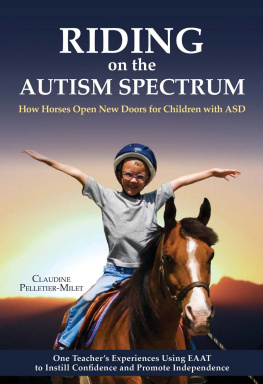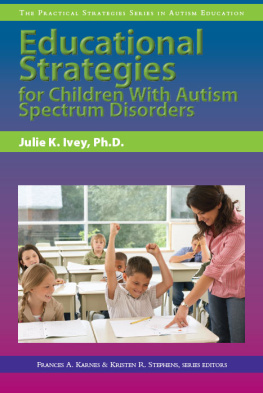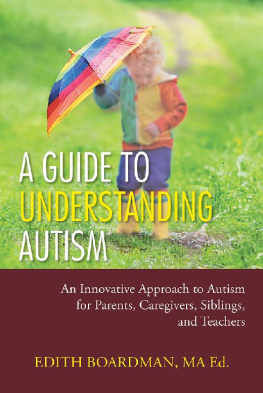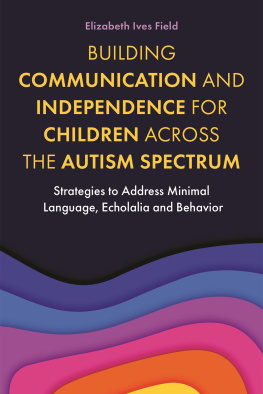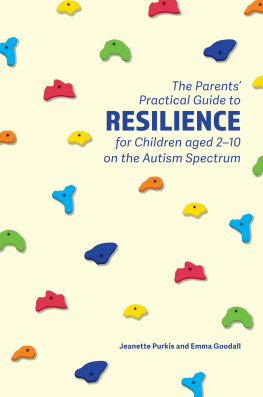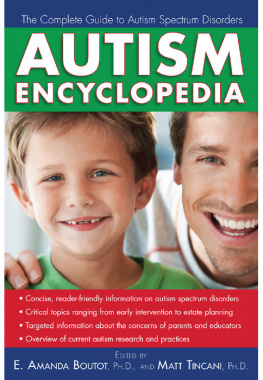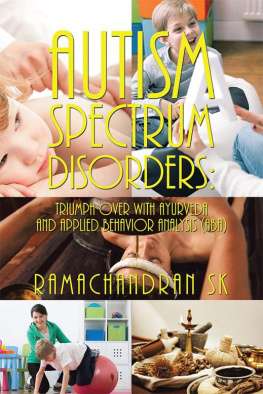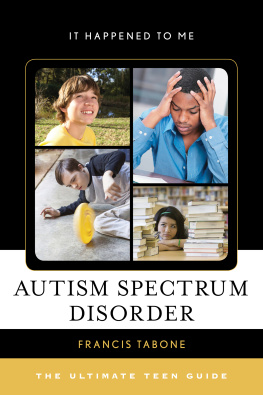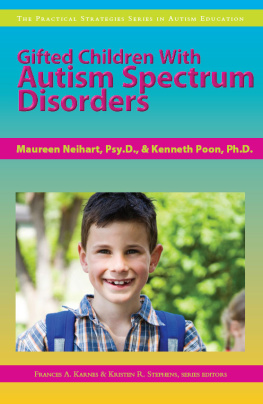
First published in 2012 by
Trafalgar Square Books
North Pomfret, Vermont 05053
Printed in the United States of America
Originally published in the French language as Poneys et chevaux au secours de lautisme by ditions Belin, Paris
Copyright 2010 ditions Belin, Paris
English translation 2012 Trafalgar Square Books
All rights reserved. No part of this book may be reproduced, by any means, without written permission of the publisher, except by a reviewer quoting brief excerpts for a review in a magazine, newspaper, or website.
Disclaimer of Liability
The author and publisher shall have neither liability nor responsibility to any person or entity with respect to any loss or damage caused or alleged to be caused directly or indirectly by the information contained in this book. While the book is as accurate as the author can make it, there may be errors, omissions, and inaccuracies.
Trafalgar Square Books encourages the use of approved safety helmets in all equestrian sports and activities.
Library of Congress Cataloging-in-Publication Data
Pelletier-Milet, Claudine.
[Poneys et chevaux au secours de lautisme. English]
Riding on the autism spectrum : how working with horses and ponies opens new doors for children with ASD/Claudine Pelletier-Milet ; translated by David Walser.
p. cm.
Includes bibliographical references and index. ISBN 978-1-57076-499-8 (pbk.)
1. Autism spectrum disorders in children--Treatment. 2. Horsemanship-Therapeutic use. 3. Horses--Therapeutic use. 4. Human-animal relationships. I. Title.
RC553.A88P4513 2012
618.92858820651581--dc23
2011050044
Photos 1 and 2 courtesy of Anthony Riviere; Photos 4, 6, and 7 courtesy of David Walser; Photos 3 and 5 courtesy of Claudine Pelletier-Milet.
Book design by Lauryl Eddlemon
Cover design by RM Didier
Typefaces: Veljovic, Kabel
10 9 8 7 6 5 4 3 2 1
Contents
Important Note
From the Publisher
A utism is a general term used to describe a group of developmental disorders, often referred to as autism spectrum disorders (ASD). % Symptoms typically appear in the first three years of life, and include restricted and repetitive patterns of behavior that affect an individuals ability to communicate and interact with others. It is estimated that autism affects one in every 110 births in the United States (one in 70 boys), and statistics show that the prevalence rate is significantly increasing annually.
Perhaps one of the most tragic aspects of this group of disorders is that those affected often withdraw from social engagementthey may fail to speak, respond, or make eye contact, while avoiding physical touch. It can seem as if the autistic individual is unable to open up to other people, or to his own emotions and feelings. This not only lays a challenging road before the person on the autism spectrum, it causes frustration, despair, and longing on the part of parents, relatives, and friends who desperately seek reciprocation of the love and affection they cannot help but feel for the autistic child in their life.
Claudine Pelletier-Milet feels that an autistic person is someone who is, in many ways, in the dark and just longing to light up. Over the last 15 years she has worked at her horseback riding stable in France, outside the mainstream debate about autism and its causes, creating a magical world in which her horses and ponies help her autistic students (her magnificent horsemen, as she calls them) develop on their own time in a joyful and relaxed atmosphere.
When we read how Pelletier-Milets horses open doors to the autistic individual, inviting him into the vast world that surrounds him to discover new sensations and learn to control his emotions and fears, we thought sharing her storiesoriginally published in the French language and with a French audience in mindworth translating. We acknowledge that the French school of thought and related research pertaining to ASD differs in depth, perception, and terminology from that in the United States and other parts of the world. We are thankful that the United States is a world leader in advancement of ASD theory and treatment. It is even with these differences in mind that we feel Pelletier-Milets personal experiences with autistic children, and the transformation she has witnessed time and again in the saddle, remain a universal source of inspiration and hope, and one that should be shared, regardless of native land or language.
Introduction to
Claudine Pelletier-Milet
and her work
By Catherine Mathelin-Vanier
S ome of you may already know about Claudine Pelletier-Milet and the equestrian center and pony club she runs outside of Paris, France. In 2004, Claudines book Un Poney Pour tre Grand (A pony to help growing up) described the work she does with babies on horseback. Ive witnessed her baby riders as she calls them, and it was this that captured my interest and rooted my fascination with Claudines techniques.
While watching these little children, some of whom were barely eighteen months old, it immediately struck me that Claudines was no ordinary riding method. She had made her time and her ponies available to these children to help them discover a new world in which they could begin to acquire independence and a desire to communicate. Here was a technique that was helping these children not only become riders, but even more importantly, grow up.
When I took my own children to Claudines pony cluband later on, my grandchildrenI formed a friendship with her that has grown stronger over time. Since I already had thirty years of experience of psychoanalysis in the field of young children, often those who were in some way hindered in their development, her work was of special interest to me. Our conversations covered many of the possible developments in bringing about change in the life of very young children through riding. Her baby riders growing equestrian skills were apparent to all, but the evident change in their naturethe growing confidence, the newfound calm of the hyperactive, and the increased animation in those that were withdrawnwas also soon apparent.
Claudine is also trained in the field of special needs education, and she soon noticed that her methods had similarly good results when applied to children identified as autistic who were sent to her by care facilities and educational groups. She agreed to enroll these children in her courses: to her, every child shares the common trait of being unique, and each has different characteristics and must cope with different problems. It was clear to her that any child, whether autistic or not, could benefit from contact with her ponies.
As you read this book you will see that Claudine is not trying to make every child the same, nor is she trying to make those on the autism spectrum somehow normal. She is simply helping each child discover the person he or she is, opening doors into our world by breaking the locks that keep them shut. She is helping autistic children discover feelings and emotionswhile learning to control themfeelings that are often limited to fears, and which can prevent those with autism spectrum disorders (ASD) from moving forward.
Claudine never makes judgments in advance, whatever the diagnosis of the child that has been sent to her. She is guided by the conviction that all children are the same in these ways: they want to live and they want to be able to make contact with other people. She assumes that children on the autism spectrum share the desire, although it is stifled, to open themselves to the world. If a child cannot communicate, he will struggle to find the courage to open himself up to another person.
Next page
